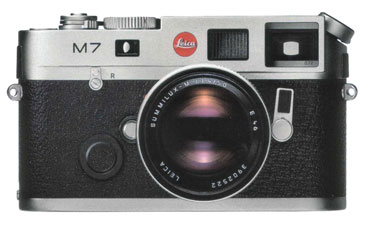


In the early days of photography, cameras were heavy devices that needed tripods
for every picture. Frustrated with their limitations, an engineer at the Leitz
company in Germany, Oskar Barnack, designed a new kind of hand-portable camera.
His 1913 prototype used a compact lens and lightweight 35mm cinema film instead
of awkward bellows and glass plates.
Within a decade, Leitz Camera (later shortened to Leica) was mass-producing Barnack’s
camera, and modern photojournalism was born. Photographers like Henri Cartier-Bresson
took their Leicas where cameras had never gone before – out on the streets,
into people’s homes and to the frontline.
From Robert Capa’s shots of the Normandy landings to Korda’s iconic
portrait of Che Guevara, Leicas captured many of the last century’s most
enduring images. They were as popular with artists as they were with photojournalists:
Robert Frank, Sebastiao Salgado and Diane Arbus all used Leicas for some of their
most famous work.
Although Japanese companies have eroded Leica’s position as the world’s
foremost camera manufacturer, Leica enthusiasts still swear by their cameras’
speed, reliability and image quality. However, Leica has struggled with the transition
to digital and recently posted a multi-million Euro loss. Time, perhaps, for a
new Oskar Barnack to devise innovations that ensure Leica’s second century
will be as successful as its first.
The Leica M7 £2050
www.leica-camera.com
Using it: Leica’s classic hand-made M-series has hardly changed in decades.
This latest version has effortless operation, a vibration-free electronic shutter
and can use virtually every Leica lens and accessory ever sold. Automatic exposure
lets you follow your photo instincts, plus it’s still small enough to slip
into a flak jacket.
The pictures: The traditional 35mm negatives will be perfectly exposed and pin-sharp,
so why not develop your own film like the photo giants of yesteryear?
Verdict: A Leica is for life. If you want simply the best build and image quality,
follow the pros and invest in an M7.
The shift to digital
At the turn of the millennium, over 90% of cameras sold used traditional
35mm film. Just six years later, nearly half the people in the UK use digital
cameras – and many millions more rely on camera phones. Even by the standards
of gadget-mad Brits, that’s a photo revolution.
The most obvious reason for digital’s success is the colour LCD screen.
Not only does this help with framing (you don’t see many pictures with cut-off
heads these days), it also lets you playback your shots instantly. If you don’t
like what you see, simply delete and try again. Digital cameras can now be made
much smaller and more flexible than film cameras. You can adjust their sensitivity
to shoot in near-darkness, tweak the way they capture colours and often record
short movie clips, too.
The digital revolution isn’t just about taking pictures. As computers have
found their way into over 60% of households and high-speed internet connections
rocket, we’re e-mailing and sharing images online on a massive scale.
Film isn’t going quietly, though. While film camera sales have slumped 70%
over the last five years, prices have fallen even faster, and there are some real
bargains to be found. Digital cameras are only now starting to rival the image
quality of film, especially for glossy fashion shoots. But even famous photographers
still shooting film, such as Mario Testino, aren’t above using computers
to ‘remaster’ their images.
In our new digital world, photos can be captured, edited and beamed around the
world in minutes, for next to nothing. And no matter how cheap film cameras become,
they’ll never match that convenience.
Leica M7 accessories
Leica Noctilux-M 50mm lens £1950
www.leica-camera.com
A 50mm ‘prime’ (fixed focal length) lens is perfect for everyday photography,
from street snaps to landscapes. This breakthrough lens boasts the world’s
first f/1 aperture. That means it’s faster than the human eye, letting you
capture pin-sharp pictures by candle-light without using a flash.
Ever-ready case M a la carte £150
www.leica-camera.com
The best insurance policy you can buy for any camera is a tough, high quality
case. This two-piece leather casing provides protection against bumps and knocks
– although it isn’t fully waterproof. It’s available in a range
of colours, from Ostrich-look Black to Racing Green, with slim carrying straps
to match. But measure before you buy, as it won’t carry all the lenses that
can fit on the M7.
Leica Vario-Elmar-R 80-200mm lens £1325
www.leica-camera.com
Even though you’ve got a proper grown-up camera, you don’t have to
do without the convenience of a zoom lens. This telephoto zoom covers longer focal
lengths, making it perfect for sports and wildlife photography, or simply beautiful
portraits. It’s small enough to take on holiday and image quality is top-notch
throughout the zoom.
Leica SF 24D flash £190
www.leica-camera.com
You don’t want to leave a camera as classy as the M7 at home just because
it’s dark. This elegant flash unit slots onto the hot-shoe and uses TTL
(Through The Lens) metering to deliver a finely judged burst of light. It even
comes with its own accessories: a smart velvet carry pouch and clip-on diffuser
screens for use with wideangle or telephoto lenses.